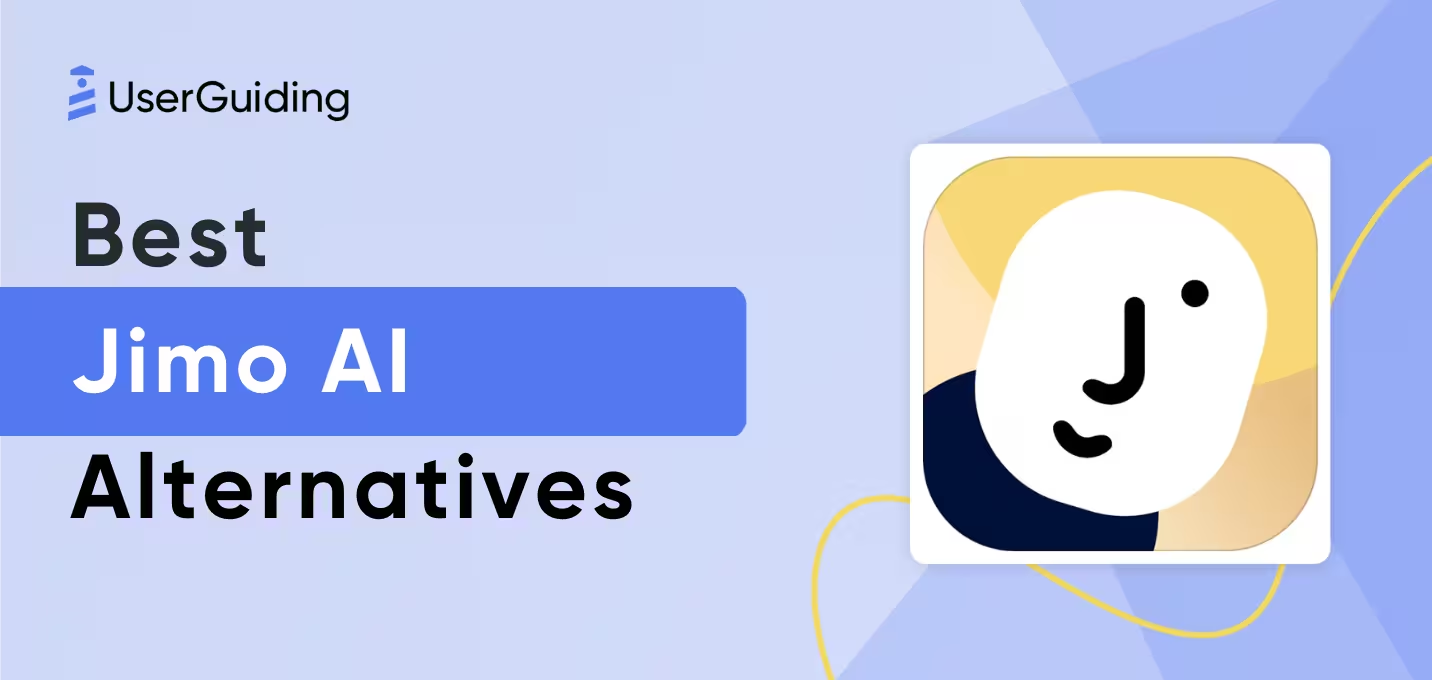

Curious about what Userpilot can actually do for your product? You’re in the right place!
In this guide, we’ll walk you through Userpilot’s top features, explore its use cases, and show how it helps businesses like yours streamline onboarding and increase user engagement.
Ready to dive in? Let’s go! 🚀
TL;DR
- Userpilot is a product growth platform that helps SaaS companies with user onboarding, feature adoption, and product engagement.
- Its most common use cases: Onboarding, engagement analytics, user research, in-app communication, mobile experiences, feature announcement, and in-app support.
- Cheapest plan: The Starter plan costs $299 per month for up to 2,000 MAUs (annual billing).
- Strong suits: Customizable flows, advanced event tracking, in-app surveys, detailed analytics, mobile app support, and reliable customer service.
- However, it falls short in areas such as affordability for small businesses, limited integrations in lower-tier plans, and a steep learning curve and usability issues, particularly for non-technical users.
- But there’s a better alternative! Meet UserGuiding, a no-code, all-in-one product adoption solution.
- UserGuiding offers more accessible pricing for small and growing businesses and provides more features across all plans, including a built-in knowledge base and AI-powered in-app support.
What is Userpilot?
Userpilot is a product growth platform designed to enhance user onboarding, drive product adoption, and improve user engagement without requiring extensive coding.
It provides tools that allow product teams to build in-app experiences like onboarding flows, feature walkthroughs, tooltips, and surveys directly within their product.
With capabilities such as user segmentation, event tracking, and A/B testing, Userpilot enables you to deliver personalized experiences based on user behavior, as well.

What is Userpilot used for?
Most SaaS companies use Userpilot for:
- Guiding users within the product
- Offering in-app support
- Monitoring user engagement and in-app behavior
- Decreasing friction and improving UX
- Personalizing user experiences
- Announcing new features and updates
- Conducting user research and collecting user feedback
- Testing and optimizing in-app content
What are Userpilot’s top use cases and features?
Userpilot lists 6 use cases on its website: user onboarding, in-app support, expansion revenue, churn prevention, product launches, and product adoption. While these are valid use cases, they are somewhat vague, general, and often interrelated.
For example, churn prevention and expansion revenue are natural outcomes of effective user onboarding or in-app support.
Because of this, we’ll adjust the use case categories slightly and reorganize them based on the actual features and capabilities Userpilot offers for each one.
User Onboarding and In-app Guidance
- Flows: Userpilot’s flow builder allows you to create step-by-step onboarding experiences (guides and walkthroughs) directly within your product. These flows can guide new users through key features, helping reduce time-to-value and increase early engagement.

- Tooltips and Hotspots: Tooltips provide contextual guidance by appearing when users hover over or interact with specific UI elements. Hotspots draw attention to new or important features using visual cues like badges or pulsating icons.

- Onboarding Checklists: Userpilot’s onboarding checklists help guide users through essential steps in the product. With smart tasks, each checklist item can be configured to trigger specific actions upon completion, such as launching an in-app flow, or redirecting the user to another page.

Product Analytics and Reporting
- Trends, Funnels, and Paths: With Userpilot, you can track how users interact with your product over time, visualize conversion funnels, and uncover user journeys to identify friction points and drop-off moments.

- Dashboards: Userpilot’s custom dashboards allow you to centralize key product metrics for a clear, real-time overview of engagement and user adoption performance.
- Retention Reports: Userpilot’s customer retention tables show how often users return and engage with your product over time, making it easier to track long-term user behavior. They help answer questions like how many users remain active after a set period or how specific actions (like sending messages) are repeated over days or weeks.
- Cohort Analytics: In your retention report, you can utilize cohort tables.

Engagement Monitoring
- Event tracking: Userpilot enables you to track specific user actions, like button clicks, page views, or feature usage.

- Feature tags: You can also tag UI elements in your product to monitor how often specific features are used. This helps identify underused features and potential areas for improvement.
- Session records: Userpilot’s session records feature allows you to capture and replay real user sessions to see how users navigate your product in real time. Useful for debugging, UX research, and support.

User Research and User Feedback
- Surveys: Userpilot helps you create in-app surveys such as NPS, CSAT, or custom questionnaires to collect user insights and valuable feedback directly from users within your product experience.

- NPS dashboard: NPS surveys have a separate dashboard and analytics part that allows you to track NPS trends over time and segment responses to better understand user satisfaction across different cohorts.
- User response analytics: You can view user responses to your surveys individually, and/or create dashboards for a bird's-eye view.
- A/B testing: With the A/B testing feature, you can run different versions of in-app materials to see which one generates more interaction and engagement. You can also target different user segments.
In-app Communication and Announcement
- Modals: These are UI modals that grab user attention for important updates, promotions, or feature announcements. You can also add clickable blocks within your modals.
- Banners: Banners are less intrusive announcements displayed at the top or bottom of the screen. They are ideal for ongoing updates or passive messaging.

- Resource center: A resource center is an in-app hub for your help materials, FAQs, as well as interactive materials, such as guides and checklists. You can link your resource center with your knowledge base through integrations, too.
Unfortunately, Userpilot doesn’t have a knowledge base feature, so you need another software to create one, or go in-house and code from scratch.
- Segmentation and localization: You can target in-app experiences based on user behavior, attributes, or language preferences to ensure messages are relevant and personalized.

Mobile Experience
- Mobile onboarding: Userpilot supports mobile apps and offers several mobile-first features, such as carousels and slideouts. You can also use other onboarding features (tooltips, hotspots, and checklists) for mobile apps, too.
- Push notifications: You can send time-sensitive or behavior-triggered notifications to re-engage users and drive mobile activity even when they’re not in the app
- Mobile analytics: Userpilot gathers mobile app engagement data on separate dashboards and allows you to monitor mobile app engagement and user behavior individually.
- Segmentation and localization: Segmentation and localization capabilities are available for mobile apps, as well.
Surveys are not available for mobile apps, yet. However, Userpilot announced that they’re on their roadmap and will be available soon.
How much does Userpilot cost?
Userpilot has 3 plans: Starter, Growth, and Enterprise.
The Starter plan is priced at $299 per month when billed annually and supports up to 2,000 monthly active users (MAU). This tier does not allow for any increase in MAU limits.
The Growth plan starts at $799 per month, billed annually, with MAU limits determined on a custom basis, though specific details aren’t disclosed on Userpilot’s website.
The Enterprise plan has custom pricing and custom MAU calculation.
The Starter plan offers only a basic set of features, covering essentials like guides, hotspots, NPS, banners, checklists, segmentation, basic analytics, and event tracking.
Other capabilities, such as resource centers, A/B testing, and customizable in-app surveys, are introduced with the Growth plan and above. Session replays, mobile-specific functionalities (including mobile analytics, tracking, and engagement), and certain integrations with tools like HubSpot and Salesforce are offered as optional add-ons.
However, these add-ons are exclusive to users on the Growth or Enterprise plans.
So if you want mobile capabilities (and are even willing to purchase them as add-ons), you can't access them on the Starter tier. You’ll need to upgrade to the Growth plan first, and then add them on.
Growth and Enterprise tiers include a comparable core feature set, but they differ in areas such as integration options, data management capabilities, account support, and usage limits.
For instance, features like localization and webhook integrations are capped in the Growth plan but offered without restrictions in the Enterprise tier.
What are the pros of Userpilot?
Userpilot offers a range of strengths, including a comprehensive feature set, responsive customer support, and a user-focused approach to product growth. Here are some of them:
✅ Easy to Use (most of the time): Userpilot is a no-code platform with an intuitive user interface and a decent onboarding process. So, most users, even those with no technical background, are able to navigate the platform and use the features.

However, it's worth noting that due to the number of features and CSS customization options, many Userpilot users say it can take some time to get fully comfortable with the platform and use it to its full potential.
✅ Feature Richness: Userpilot offers a broad set of features and capabilities, particularly in product analytics and engagement reporting.
In addition, its onboarding tools, event tracking, session recording, and mobile support make it a strong choice for many SaaS companies.

✅ Detailed Analytics: Userpilot offers a variety of reporting and analytics capabilities, including customizable dashboards and multiple table and chart formats for different report types, such as cohort analysis.
It also provides segmentation and filtering options.
The platform’s event tracking and session replay features complement its analytics capabilities and offer a more complete view of your users’ behavior patterns.

It’s important to note that Userpilot is not a dedicated analytics tool.Its analytics capabilities should be evaluated in comparison to other product adoption and engagement platforms, not tools focused solely on analytics.
If your primary use case is deep engagement analytics, Userpilot may fall short.
However, if you need reasonably detailed and customizable reporting within a broader product experience platform, it should meet your expectations.
✅ Reliable Customer Service: Many Userpilot customers report that the platform’s customer support team is responsive, easy to communicate with, and quick to resolve issues. Several users have even noted receiving direct assistance with creating specific flows.

What are the cons of Userpilot?
Several drawbacks, including usability challenges, feature limitations for certain use cases, and a relatively high price point, should also be considered before deciding whether Userpilot is the right fit.
❌ Learning Curve: While it may not be as steep as the learning curve of tools like Pendo or WalkMe, Userpilot does have its own learning curve, particularly when it comes to advanced features and customization options.
Non-technical users often report needing onboarding support and guidance from either their internal teams or Userpilot’s customer support. Some also noted a desire for more in-app guidance/ user training, as they had to figure out certain aspects through trial and error.

❌ Clunky UI: Some users have reported that Userpilot’s interface can feel unintuitive or clunky, especially when navigating more complex features or managing a large number of flows.

Some users also complain about the usability of the plugin, as well.

❌ Expensive pricing: Userpilot is positioned on the higher end of the pricing spectrum, starting at $299/month when billed annually. Even users who are satisfied with the platform’s features often find the pricing to be a barrier, particularly for small and mid-sized businesses.

❌ Limited Integrations: The platform offers fewer native integrations compared to similar tools in the same category, which can be a drawback for teams relying on a broader tech stack.
Additionally, many of the available integrations are not included in the Starter plan and are only offered as add-ons for the Growth and Enterprise tiers, which feels restrictive, especially given the already high pricing of these plans.

❌ Lacks Certain Features: Userpilot offers a fairly comprehensive toolkit, but it’s not an all-in-one solution. Some users point out the absence of project management features, such as a product roadmap, while others note the lack of AI capabilities, both for internal use and for end-users, like AI agents.
Additionally, the platform doesn’t include standalone features like a built-in knowledge base, which could limit its utility for certain teams.

❌ Confusing and Limited Customization: While Userpilot supports CSS-based customization, it can be difficult to use for non-technical users.

Aside from the CSS customization, the no-code customization options can feel limited.

A better alternative to Userpilot: UserGuiding
If the pros of Userpilot do not outweigh the cons for you, meet UserGuiding.
UserGuiding is a no-code, all-in-one product adoption platform designed to assist with feature engagement, in-app communication, user insights, and in-app support. Its features and capabilities include:
- Interactive product tours
- Onboarding checklists
- Hotspots and tooltips
- Announcement modals (banners, slideouts, pop-ups, etc.)
- NPS and custom in-app surveys
- AI assistant
- Resource center (in-app)
- Knowledge base (standalone)
- Product updates (standalone)
- Segmentation
- Analytics

UserGuiding and Userpilot have several common features and offerings, especially when it comes to in-app guidance and onboarding.
Both tools offer similar interactive walkthroughs/ product tours, tooltips, hotspots, and onboarding checklists.
Where they differ is in their other offerings and feature depths, such as analytics, standalone features, and AI capabilities.
UserGuiding is an all-in-one product adoption platform, meaning that it does not solely focus on the in-app experience or communication but also allows you to engage with your users outside of your app through a knowledge base and a product updates page.
Here’s what a knowledge base created with UserGuiding looks like:

And here’s a product updates page:

Another feature that UserGuiding offers, which Userpilot lacks, is the AI assistant.
UserGuiding’s AI assistant enables in-app support and guidance with a conversational tone.
For users who prefer self-service support but dislike searching for information, the AI assistant provides a middle ground between human customer support and a self-serve knowledge base or help center.

How much does UserGuiding cost?
UserGuiding has 1 free and 3 paid plans: Support Essentials, Starter, Growth, and Enterprise.
The Starter plan begins at $174/month (billed annually) for up to 2,000 MAU, while the Growth plan starts at $349/month (billed annually) for the same MAU limit. UserGuiding uses transparent, MAU-based pricing, allowing you to estimate your costs directly on the pricing page using an MAU slider.
For reference, when the MAU increases from 2,000 to 5,000:
- The Starter plan is priced at $209/month (billed annually)
- The Growth plan starts at $419/month (billed annually)
The Enterprise plan has custom pricing.
Another key advantage of UserGuiding’s pricing model is the availability of monthly billing. While not as cost-effective as annual billing, it provides flexibility. Annual plans generally offer around 30% savings compared to monthly contracts.
As we mentioned above, UserGuiding offers a free plan as well. Within its Support Essentials plan, UserGuiding assists you with features such as resource center, knowledge base and product updates.
UserGuiding also has an edge over Userpilot when it comes to what’s included in each pricing tier.
While Userpilot reserves certain key features, like resource centers and in-app surveys, for its higher-tier plans, UserGuiding includes nearly all of its core features even in the Starter plan. The only exceptions at this tier are advanced CSS customization, A/B testing, and goal tracking.
UserGuiding manages to offer broad feature access while keeping pricing reasonable by implementing feature caps. These usage limits are increased (or entirely lifted) as you move to more advanced plans.
In short…
Userpilot is a powerful platform with smooth in-app guidance, onboarding features, and solid analytics capabilities. It also excels in event tracking and session recordings.
However, it falls short in a few areas: its pricing is relatively high, the features and customization capabilities can be intimidating for non-technical users, and some key features (like in-app surveys or resource centers) are locked behind higher tiers.
Integration options are also limited.
UserGuiding, on the other hand, offers a more accessible all-in-one solution with broader feature availability across tiers, easier usability, and additional capabilities like an AI assistant, a knowledge base, and a public product updates page.
So, the decision is yours.
Will you go with Userpilot for its advanced analytics and mobile support?
Or choose UserGuiding for its flexibility, accessibility, and all-in-one simplicity?
Frequently Asked Questions
What does Userpilot do?
Userpilot is a product growth platform designed to help SaaS companies create personalized user onboarding experiences and improve product engagement. It provides in-app guidance, tooltips, walkthroughs, checklists, and surveys to guide users through the product. The platform also offers analytics and event tracking to monitor user behavior, helping teams optimize the user experience.
How much does Userpilot cost per month for small SaaS teams?
Userpilot’s Starter plan is priced at $299 per month when billed annually, catering to small SaaS teams with up to 2,000 monthly active users (MAU). This plan offers core features like onboarding flows, tooltips, checklists, and basic analytics. While suitable for small teams, it may not be the most cost-effective option for startups with tight budgets or limited resources.
How much do Userpilot’s pricing plans differ for startups and enterprises?
Userpilot's pricing plans vary significantly between startups and enterprises. The Starter plan is designed for smaller businesses or early-stage startups, while the Growth and Enterprise plans are tailored to scaling businesses and larger organizations. The Growth plan starts at $799 per month, offering more advanced features, including additional integrations, event tracking, and increased customization. The Enterprise plan is custom-priced.
What’s included in the Userpilot Growth plan pricing?
The Userpilot Growth plan, starting at $799 per month (billed annually), includes a comprehensive set of features aimed at scaling SaaS teams. It covers user engagement tools like onboarding flows, in-app surveys, and tooltips. The plan also provides advanced analytics and reporting capabilities, including retroactive event capturing. Additionally, the Growth plan offers access to add-ons, like session recording and mobile app support.
Is Userpilot worth the price for early-stage product-led teams?
For early-stage product-led teams, Userpilot can be a valuable tool with smooth onboarding and user engagement features to improve user adoption. However, its pricing may be a challenge for smaller startups, especially considering the higher costs associated with the Growth and Enterprise plans. While it offers a lot of customization and detailed analytics, small teams might find more cost-effective alternatives, such as UserGuiding or Product Fruits.

















.svg)
.svg)
.svg)
.svg)
.svg)

.svg)
.svg)












.svg)
.svg)





.png)















